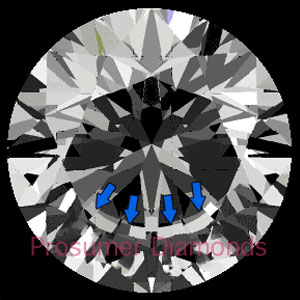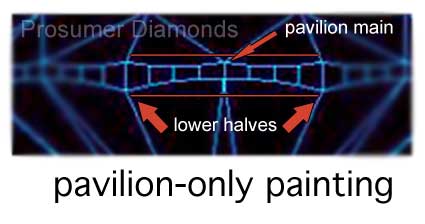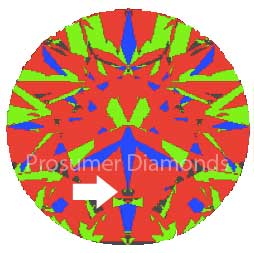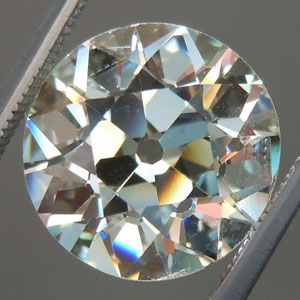The Girdle
In my how to pick a diamond tutorial, I recommended a thin-to-medium girdle. To understand why I prefer this range, you first need to understand the purpose of the girdle.
The reason a diamond has a girdle is for protection. A thick girdle is less prone to chipping than a thin girdle. The problem is that a thick girdle is bad for the diamond’s spread. You’re essentially paying for carat weight that isn’t making the diamond look bigger.
A typical girdle is actually made up of 64 individual facets, 4 girdle facets per upper or lower girdle facet. In some cases the girdle may have 96 or even 128 facets. It’s not often talked about, but in my opinion the girdle actually plays a part in light performance.
First, some of the light that enters the diamond through the table facet will leave through the girdle rather than the crown. The girdle actually does a fairly good job at dispersing light. Very often in real life, I will notice fire from the girdle when the rest of the diamond is not doing anything when viewed from the side. Larger and fewer girdle facets will mean bolder flashes and lots of smaller girdle facets will enhance pin-fire flash.
So it seems that there is a trade-off between durability and light performance, and spread.
Durability
When you’re spending so much money on a diamond, of course durability is an important consideration. But the reality is that the risk of chipping a diamond is not greatly affected by the thickness of the girdle unless it’s extremely thin.
Diamonds are brittle and yes, they do chip occasionally if you’re not careful with them. But durability is only a big issue when you have an open crack in the diamond in a place where it is likely to have future accidental impacts like the girdle.
Now an open crack in a diamond is called a cavity and is labelled in both red and green on the clarity plot. If you have a diamond with a cavity that reaches the girdle edge, then you should not use a prong to cover up those open cracks as this will make it more likely for the crack to propagate.
It’s much more common to be stressing over a feather that reaches the girdle edge. A feather is an internal crack that touches but does not breach the surface of a diamond so is considered an inclusion. If you’re worried about a VS clarity feather on a diamond, you really shouldn’t be.
I wouldn’t even worry about an SI clarity feather unless it reached the girdle edge. Bear in mind that the diamond has gone through much more stress and strain in its formation.
Cavities and feathers are much more important considerations for the jeweller when setting a diamond. This is something you should consider if you’re purchasing a loose diamond. If a diamond survives the setting process, then the durability isn’t usually a problem since the stresses of normal day-to-day wearing pales in comparison.
Of course, when you have a choice, you can always play safe. Depending on the clarity grade, I personally wouldn’t recommend a diamond with a large feather (SI or lower) that is very near surface of the diamond. The reason is that it may one day become a cavity if by shear dumb luck that feather is subjected to a precise impact that makes the crack grow and breach the surface.
Lower Girdle Indexing
While upper girdle indexing or ‘crown-only’ painting is sometimes used to enhance the beauty of the diamond, lower girdle indexing is considered to be detrimental to the appearance of the diamond whether it is painting or digging. If you haven’t read the upper girdle tutorials you should do that first.
You can see that in the diamond with crown-only painting (left), the girdle at the lower half and at the pavilion main is aligned at the bottom but not at the top. In the diamond with both crown and pavilion painting (right), the girdle at the pavilion main is thinner than the girdle at the lower half both from the top and the bottom.
So let’s just have a look at what happens when you only paint the lower girdles while having a classic upper girdle cut at index 2.
You can see how about 4 degrees of painting of the lower girdles will lead to significant increases of green in the ASET. Another thing you can see is how the hotspots get smaller the more you paint the lower girdles, which makes sense since the lower girdle becomes shallow as if you were making them shorter.
Further painting introduces significant increases in blue and green, such that anything above 5 degrees of painting will have significant obstruction problems that will make the diamond appear dark, first around the edges of the diamond and then the entire diamond.
The Fish-eye Effect
In my tutorial on the pavilion depth and table, I mentioned that a bigger table or shallower pavilion leads to a bigger fish-eye. Fish-eye being the term given to the reflection of the girdle as seen through the table. In an ideal cut diamond, you should not be able to see the fish-eye effect from face-up.


(The image on the left of the ‘fish-eye’ effect is © GIA. Reprinted by permission.)
The diamond on the left displays the fish-eye effect clearly. It’s the white band that you see outlining the inside of the table facet. This diamond has a very large table and you can see that the table facet forms a convex shape with the star facet.
The pavilion is also shallow, as the table reflection is small for such a large table. The deadly combination of a large table and a shallow pavilion results in this obvious fish-eye. Now the image on the right is of a diamond with a 60% table that is tilted to -15 degrees. You can see that the girdle reflection is visible at the bottom of the table. It’s difficult to put into words, but if you move the diamond around, you’ll be able to see the rest of the girdle reflection. A visible girdle reflection when viewed from an angle is why I don’t recommend diamonds with over 60% tables.
The reflection of the girdle is always visible in a diamond when tilted. You can minimise this by having a smaller table, but you can still spot the girdle reflection even in the diamond with a 55% table with a 40.8 degree pavilion tilted at +15 degrees. I have found that a 58% table or lower is safe if you don’t’ want to have a noticeable girdle reflection.
The Culet
Finally I want to say a few words on the culet. The culet is why officially there are 58 facets in a round brilliant cut and not 57. Most round brilliant diamonds are cut to a point or have no culet.
Having a small culet helps prevent the diamond from chipping at the base where it is very fragile. A diamond used to not be able to get top grades for having no culet, but as society’s preferences changed, the labs have recognised that people generally do not like the effect the culet has on the appearance of a diamond.
This is because culets can be visible through the table of the diamond and looks very much like a small inclusion.
Older cuts like the Old European Cut (OEC) and Old Mine Cut (OMC) will have larger culets and the culet is very much a part of their appeal. However, small to medium sized culets are generally hard to see without close inspection.




